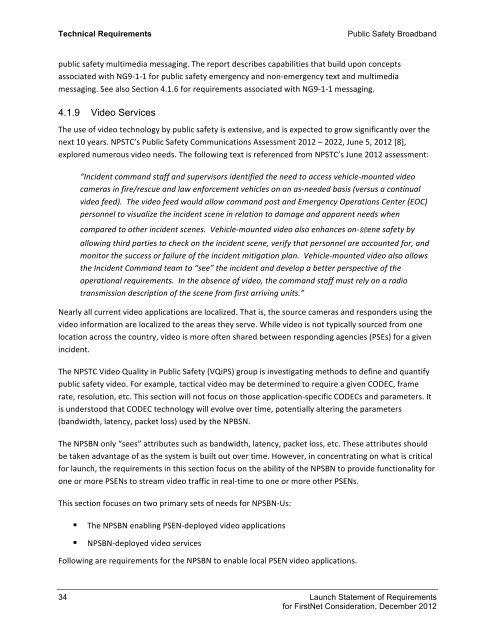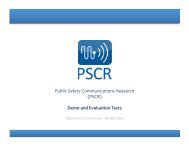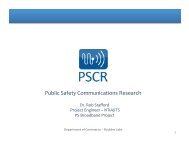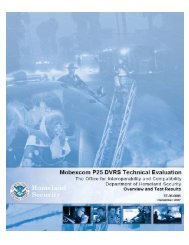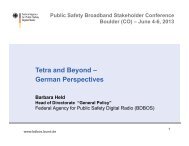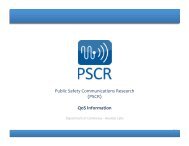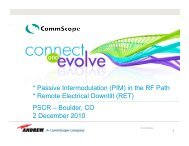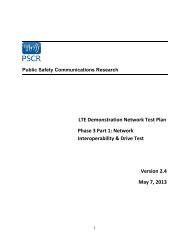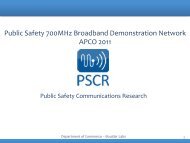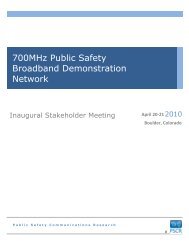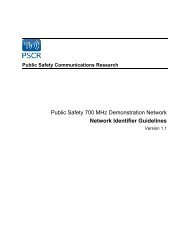Launch Requirements - PSCR
Launch Requirements - PSCR
Launch Requirements - PSCR
You also want an ePaper? Increase the reach of your titles
YUMPU automatically turns print PDFs into web optimized ePapers that Google loves.
Technical <strong>Requirements</strong><br />
Public Safety Broadband<br />
public safety multimedia messaging. The report describes capabilities that build upon concepts <br />
associated with NG9-‐1-‐1 for public safety emergency and non-‐emergency text and multimedia <br />
messaging. See also Section 4.1.6 for requirements associated with NG9-‐1-‐1 messaging. <br />
4.1.9 Video Services<br />
The use of video technology by public safety is extensive, and is expected to grow significantly over the <br />
next 10 years. NPSTC’s Public Safety Communications Assessment 2012 – 2022, June 5, 2012 [8], <br />
explored numerous video needs. The following text is referenced from NPSTC’s June 2012 assessment: <br />
“Incident command staff and supervisors identified the need to access vehicle-‐mounted video <br />
cameras in fire/rescue and law enforcement vehicles on an as-‐needed basis (versus a continual <br />
video feed). The video feed would allow command post and Emergency Operations Center (EOC) <br />
personnel to visualize the incident scene in relation to damage and apparent needs when <br />
compared to other incident scenes. Vehicle-‐mounted video also enhances on-‐scene safety by <br />
allowing third parties to check on the incident scene, verify that personnel are accounted for, and <br />
monitor the success or failure of the incident mitigation plan. Vehicle-‐mounted video also allows <br />
the Incident Command team to “see” the incident and develop a better perspective of the <br />
operational requirements. In the absence of video, the command staff must rely on a radio <br />
transmission description of the scene from first arriving units.” <br />
Nearly all current video applications are localized. That is, the source cameras and responders using the <br />
video information are localized to the areas they serve. While video is not typically sourced from one <br />
location across the country, video is more often shared between responding agencies (PSEs) for a given <br />
incident. <br />
The NPSTC Video Quality in Public Safety (VQiPS) group is investigating methods to define and quantify <br />
public safety video. For example, tactical video may be determined to require a given CODEC, frame <br />
rate, resolution, etc. This section will not focus on those application-‐specific CODECs and parameters. It <br />
is understood that CODEC technology will evolve over time, potentially altering the parameters <br />
(bandwidth, latency, packet loss) used by the NPBSN. <br />
The NPSBN only “sees” attributes such as bandwidth, latency, packet loss, etc. These attributes should <br />
be taken advantage of as the system is built out over time. However, in concentrating on what is critical <br />
for launch, the requirements in this section focus on the ability of the NPSBN to provide functionality for <br />
one or more PSENs to stream video traffic in real-‐time to one or more other PSENs. <br />
This section focuses on two primary sets of needs for NPSBN-‐Us: <br />
! The NPSBN enabling PSEN-‐deployed video applications <br />
! NPSBN-‐deployed video services <br />
Following are requirements for the NPSBN to enable local PSEN video applications. <br />
34 <strong>Launch</strong> Statement of <strong>Requirements</strong><br />
for FirstNet Consideration, December 2012


